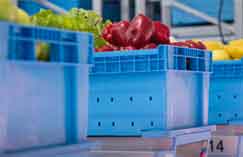Some two decades at pioneering on-line grocer Webvan went belly up, consumers really do seem to be warming to ordering groceries over the web, even if they can't squeeze the celery before it's placed in a virtual cart.
On-line grocery sales rose 15% in 2019, according to research from consulting firm Brick Meets Click.
Supply Chain Digest Says...
|
 |
In the still dynamic world of ecommerce and efulfillment, keeping your options open is the smart strategy. |
 |
What do you say? |
| Click here to send us your comments |
 |
| Click here to see reader feedback |
|
But as volumes grow, logistics become essential to customer satisfaction and financial success - and there are competing models.
One approach is to use the grocery stores themselves as the fulfillment point, with employees navigating the aisles with pick lists, after which the orders are either delivered to consumer or picked in a process that was for a while at least was referred to as "click and collect."
But there are some issues with that model, starting with high labor costs versus more focused fulfillment operations. And grocers using that model have received feedback from customers that competing in the aisles with comparatively fast-paced pickers for on-line orders is irritating.
What the store fulfillment model does provide is the greatest proximity to customers in terms of delivery, with grocers often operating many stores in a given metro market, just minutes from many consumers.
And proximity is the downside of another model, using a single, large and generally highly automated fulfillment center for all on-line orders in a given market.
This is the path that Kroger is taking. As we've reported many times, Kroger is partnering with a UK company called Ocado, which is the country's largest on-line grocer. But it appears now to be more focused on its own robotic picking system.
The system uses robot that sit atop a rectangular grid, with containers beneath the grid holding thousands of items. The robots move at about nine miles an hour, controlled by software that knows what items are needed for orders at any given time.
Each robot lowers a hook and the grabs and pulls in a container, then moves across the grid to a location where a stationary human associate stands below. After the robot lowers the container, the work either replenishes the container if it is empty, or selects items from the container for customer orders, before the robot moves on.
Kroger has broken ground in Ohio on the first of what it says will be as many as 20 fulfillment centers that will use the Ocado technology - and indeed Ocado will also manage by the company.
Grocer Ahold Delhaize's Peabody division is also using the large, central fulfillment center model.
Those types of facilities hold the promise of high levels of efficiency and the lowest picking costs per order – but come with some downsides too.
First, the large, highly automated DCs can be very expensive – in Kroger's case, more than $50 million for the first facility.
(See More Below)
|
CATEGORY SPONSOR: SOFTEON |
|
|
| |
|
|
Using one facility for a whole market will also result in high transportation costs versus store-based fulfillment and multiple sites.
But perhaps most important of all, the Kroger strategy was apparently based on a next day delivery paradigm – whereas in the meantime the model is moving quickly to same day – almost an impossibility with the centralized approach.
Will the Third Way Prove the Winner?
Increasingly, US grocers are turning to a third way – smaller, dedicated efulfillment centers near stores.
 The Wall Street Journal recently reported that Albertsons, Walmart, Meijer and other chains are gravitating to this approach, which sometimes goes by the term "micro-fulfillment centers." The Wall Street Journal recently reported that Albertsons, Walmart, Meijer and other chains are gravitating to this approach, which sometimes goes by the term "micro-fulfillment centers."
According to Jefferies Group LLC, these facilities typically range from 10,000 to 20,000 square feet in size and can fulfill about 4,000 orders a week. These warehouses can be built in three to six months and reach profitability in about a year.
And in a twist, many of these smaller facilities will use sort of new age automation, including offshoots of mini-load AS/RS systems to maximize storage density while reducing costs and increasing speed for fast moving items. (See Interesting Developments in "Microfulfillment" Technologies.)
Albertsons with its Safeway and Jewel-Osco chains is adding these small fulfillment facilities at two stores in San Francisco and San Jose, in partnership with Takeoff Technologies Inc., which builds automated fulfillment centers. The 10,000-square-foot distribution centers cost about $3 million to build, and Albertson's says it is adding more of them.
There is only one thing in all this that is clear: in the still dynamic world of ecommerce and efulfillment, keeping your options open is the smart strategy.
What do you think is the best grocery fulfillment model and why?i Should companies focus on keeping options open? Let us know your thoughts at the Feedback section below.
|